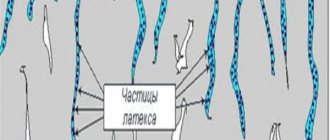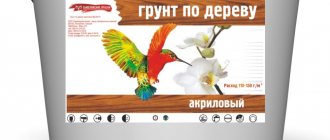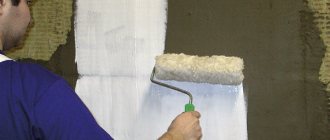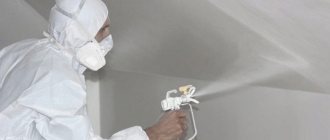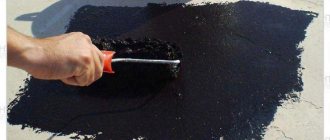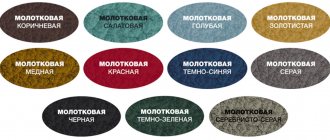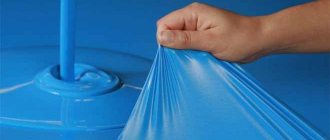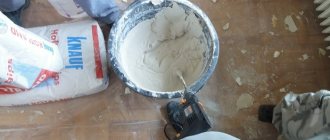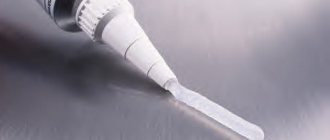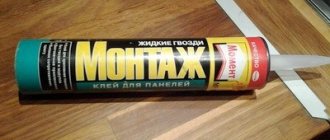Andrey
4311 0 2
Andrey June 26, 2017 Specialization: facade finishing, interior finishing, construction of dachas, garages. Experience of an amateur gardener and gardener. We also have experience in repairing cars and motorcycles. Hobbies: playing the guitar and many other things that I don’t have time for :)
Water-based primer (water-dispersion) - what kind of material is it and what is it used for? I will talk about all the technical parameters and share my experience in applying primer, which will certainly help beginners avoid mistakes when working with this coating.
Water-dispersed soil performs a number of functions, including improving adhesion and strengthening the base
general description
Structurally, such primers are a dispersion of acrylate polymers in water. As you can already judge by their name, products of this type are made without the use of chemical solvents. They are produced on the basis of ordinary water.
Essentially, such primers are liquids that contain a very large number of undissolved microscopic particles. After the water dries, the latter remain on the surface, polymerize and form a thin, durable film.
What is a deep penetration primer for and how does it work?
An indicator for using a deep penetration primer is a dusty surface. That is, dust cannot be completely removed. How can I check this? A surface is considered “dusty” if a trace remains on the hand after touching, even after thorough and (if possible) wet cleaning. Only in this case does it make sense to use this type of primer. In other cases, it will be cheaper to use film-forming or filling agents.
So what surfaces is deep penetration primer used for? For chalk surfaces, gypsum plaster before applying paint or wallpapering. Is it necessary to prime plaster under gypsum putty? No, they will “make friends” well anyway. It will also be necessary to process all sheet materials in which gypsum is used as a binder: gypsum plasterboard, gypsum plasterboard, tongue-and-groove slabs.
If the material is based on lime or gypsum binder, it is “dusty”. To prevent this from happening, deep penetration primers are applied.
Asbestos is also treated with a deep penetration primer, although it is not on plaster, it generates dust. And also silicate blocks before applying a layer of plaster. They also leave a layer on the hand. In general, it seems clear.
Note! The surface to be treated should not be loose. There is a special primer for this, called strengthening. It also belongs to deep penetration soils, but contains a larger amount of adhesives (and is more expensive). If used unnecessarily, the absorbency may be too low and cause problems.
How deep penetrating soil works
How do deep penetration primers work? They are made on the basis of the same polymers, only modified in such a way that the particles have very small sizes. The difference can be appreciated by comparing a soccer ball and a tennis ball. The particles in ordinary and penetrating soils differ by approximately the same factor. It is clear that smaller particles penetrate deeper.
Impregnation or deep penetration primer works something like this
Very small particles of the polymer dissolve and penetrate with the liquid through capillaries deep into the primed surface. After drying, the polymer particles remain in the capillaries, creating an additional crystal lattice there and reducing the porosity of the material (and its absorbency at the same time), creating additional bonds between the particles of the material. As a result, after treatment the surface stops becoming dusty.
What happens when treated with a conventional primer? Moisture is absorbed into the surface, and larger particles of polymers remain on the surface, only slightly penetrating inside. After drying, the polymer is concentrated in the upper small layer. This is sufficient for ordinary non-dusting substrates. Now, we hope, the difference between a regular primer and a deep-penetrating primer is clear.
Deep penetration primer: which is better?
As usual, there are many different brands on the market. There are Russian and imported. Of the imported ones, German Knauf and Polish Ceresit are often found. These are companies that have been on the market for many years. There are very few complaints about the quality of their products. But there are a lot of fakes and you need to know well the distinctive features of authentic products.
Deep penetration primer: what it’s needed for seems clear, but you also need to choose a manufacturer
There are also Russian manufacturers who have also been on the market for a long time and who monitor quality - these are Yunis, Starateli, Volma. What is typical is that the difference in price with the “Europeans” is very small - no more than 10-15%! There are also cheaper brands, with a more significant difference - up to 30%!, but their reputation is unstable. And if you look at the description, you can find the difference.
We recommend: Degreasing the primer before applying paint.
Benefits of use
The main advantage of water-dispersion primers is their absolute harmlessness. Unlike compositions prepared on the basis of chemical solvents, when mixed or applied to surfaces, products of this type do not emit any unpleasant odors. The only thing is that a master working with such a primer should try to avoid getting its drops in the eyes. It is not necessary to open windows and doors when using this composition indoors.
The undoubted advantages of primers of this type are also ease of use and non-flammability. Such compositions are applied to the walls using a regular paint roller or brush. Work on surface treatment using them can be done very quickly, even if it is necessary to coat in two layers. These primers dry very quickly. Since these products are prepared on the basis of water, they cannot burn in principle.
Of course, the advantages of such primers include their effectiveness. The film they create serves as an excellent base for paints.
Acrylic primer: features of selection and application
An acrylic-based mixture is one of the popular types of primer compositions due to its versatility in use. This solution is used to treat various surfaces before finishing: this increases adhesion, protects the surface from fungus and mold, and also reduces the consumption of paints and adhesives. Features of the selection and use of acrylic primer will be discussed in more detail in this article.
Peculiarities
Acrylic primer is a liquid solution based on acrylic dispersion and special components. The peculiarity of this composition, first of all, lies in its protective qualities. The mixture is well absorbed into surfaces that have a porous structure, thereby strengthening the base. When the solution dries, a high-strength protective film is formed on the surface, which, in turn, improves adhesive properties and helps reduce the consumption of paint or adhesive material.
Acrylic primers may vary in composition and some properties. However, all acrylic-based mixtures have common features and characteristics:
- the soil makes the treated surfaces more durable, especially if a deep-penetrating or strengthening mixture is used;
- reliable protection against moisture: the film created on the surface repels water;
- increases the level of adhesion: the finishing coating will adhere well to the primed base;
- reduces the consumption of paint and varnish or adhesive mixtures during finishing;
- vapor permeability;
- good covering ability: dark-colored surfaces treated with acrylic primer will not show through under the finishing layer of light-colored paint.
Acrylic-based mixtures may contain a different set of components. However, acrylic primers also have common substances in their composition:
- water or organic solvent as a base;
- binding elements that provide the solution with a certain viscosity: drying oil, various resins, polymers;
- dyes;
- catalysts that speed up the drying process of the primer mixture;
- special additives that give the solution certain qualities: antifoaming agents, biocides.
Specifications
The properties of acrylic primer mixtures may vary slightly depending on the composition. When purchasing an acrylic-based solution, you should pay attention to the following technical characteristics:
- Mixture consumption. It is worth considering that the consumption of the mixture depends on the material from which the structure being treated is made, the type and form of release of the priming solution. More accurate indicators of consumption per square meter are always indicated in the list of technical indicators on the product packaging. It is worth remembering that aerosol mixtures are used up the fastest.
- Best before date.
- Presence of toxic components in the composition. This indicator is especially important when work will be carried out indoors. To minimize harm to health, it is better to purchase environmentally friendly formulations without organic solvents.
We recommend: How to remove primer from different surfaces
What are the disadvantages?
There are practically no downsides to primers of this type. Plasterers and painters consider the only drawback of this type of products to be that they can only be stored at above-zero, preferably room, temperature. When freezing, water-dispersion primers lose their quality. They must also be transported in compliance with certain rules.
Products from this group can only be applied to surfaces at temperatures from +5 °C and air humidity up to 80%. Under other conditions, a dispersion film on the enclosing structures simply will not form. This, of course, can also be considered some disadvantage of this type of product.
A distinctive feature of water-dispersion primers is, among other things, that they, unlike chemical compounds, create a very thin film on surfaces. Therefore, walls, ceilings and facades should be prepared as thoroughly as possible before using them.
Application methods
Several methods of painting surfaces are used in repair and construction work:
- brush;
- roller;
- air and airless spray.
Acrylic dispersion paint contains water, and this is the basis for the following rules:
- The material is applied at air and working surface temperatures of +5 °C and above (unless there are additional instructions).
- Do not apply to wet or unsanded surfaces painted with glossy paints.
- It is advisable to use corrosion-resistant painting tools. After work, they must be thoroughly washed and dried.
- During the application process, do not spill the prepared paint; after drying, it is very difficult to remove.
- You can start using painted products and surfaces no earlier than one day later. Despite the fact that the paint sets very quickly, the declared properties appear approximately a week after application.
Usually VDK is diluted with water without loss of consumer properties up to 5% by weight.
What varieties are there?
All currently produced water-dispersion primers are divided into three main types:
- polyvinyl acetate - the cheapest, do not tolerate high humidity;
- butadiene styrene - not too expensive, not afraid of moisture, but not particularly frost-resistant;
- acrylic - the most expensive, versatile, and can withstand low temperatures and high humidity.
It is the latter type of product that is most popular among plasterers and painters. Acrylic water-dispersion primers are, among other things, abrasion-resistant and elastic.
By area of use, products of this type are classified into:
- universal;
- adhesive;
- deep penetration;
- anti-corrosion.
Technical characteristics of water-dispersion primer
Such compositions are produced by companies in Russia, taking into account the standards provided for by GOST R 52020-2003. Products of this type placed on the market must meet the following requirements:
- number of non-volatile substances - no more than 28;
- drying speed - up to 14 hours;
- density - 1 kg/dm3.
When purchasing this product, you should also look at such an indicator as consumption. For water-dispersion primers, according to the standards, this value should be equal to 0.1-0.6 l/m2.
Types and characteristics
The composition and technical requirements of aqueous primers must meet the standards of GOST R 52020-2003.
Water primer gets its name from the use of water as the main diluent. That is why all types of compounds are environmentally friendly and safe.
Water-based primer has several classifications, distinguished by functions and compositions. Depending on the functions performed, soils are divided into several types:
- Adhesive primer. Its main purpose is to increase adhesion between the surface being treated and the finish.
- Strengthening, used for treating loose and old bases.
- A water-dispersion deep primer designed to fill all, even very deep, surface microcracks. The composition is capable of penetrating 10 cm deep.
- Insulating, forming a thin film designed to protect the base from external influences.
- Anti-corrosion primer used for treating metal surfaces to protect them from corrosion.
- Antiseptic, playing the role of a kind of protector of the bases from the proliferation of fungal spores.
- Universal, combining the properties of all of the above compounds.
The composition of the primer may vary according to the main structural element, which was the reason for the gradation:
Water-based acrylic primer
The main components contain acrylic polymers mixed with plasticizing and elasticizing additives. In turn, such soils are divided into the following subtypes:
- adhesive;
- deep penetration.
The scope of application is quite extensive, including painting concrete, plasterboard, wood, plastered, puttied, fiberglass surfaces, etc.
Water-dispersion alkyd primer
Despite the presence of alkyd resin in the composition, the solution is absolutely harmless to humans. Thanks to the aquatic environment of the soil, the harmful effects of alkyd substances are reduced.
The use of such primers is appropriate for treating poorly absorbent substrates (plastic, metal, tiles, glass, etc.).
Latex primers
They are rightly called ideal. Their technical parameters significantly exceed the properties of alkyd and even acrylic water-dispersed primers.
The latex film-forming agents included in the composition provide excellent moisture resistance. Their use is not limited to use only on prepared surfaces.
Silicone primer
Combines the qualities of latex and acrylic. Due to this, it is quite versatile and can be used on both porous and poorly absorbent surfaces.
Areas of application
One of the undoubted advantages of water-dispersible products is their versatility. According to regulations, the following surfaces are allowed to be coated with such compounds before painting:
- mineral - concrete, blocks, brick, plasters;
- wood, OSB, chipboard, etc.;
- GKL;
- metal;
- plastic.
Such products are very widely used for all these surfaces. At the same time, the preparation of such materials before painting using water-dispersed agents is very high quality.
Universal formulations
Primers of this type are in most cases used for pre-treatment of plastered, brick or plasterboard surfaces.
Products of this type can improve the adhesion of all materials and at the same time strengthen them. Also, such primers have antiseptic properties. That is, for example, fungus does not form on surfaces when they are subsequently used. Accordingly, the walls themselves, treated with this composition before painting, can last as long as possible.
Adhesive agents
Primers of this group are used to treat very smooth surfaces. This could be, for example, concrete or plastic. They can also be used for ceramics, glass, and painted materials.
The water-dispersion primer “Concrete Contact”, which is very popular among plasterers, painters and home craftsmen, belongs to this type. Products of this type can significantly increase the adhesive properties of smooth surfaces. The paint on such materials subsequently lays down in an even layer and lasts for a very long time.
Anti-corrosion agents
Primers of this type contain substances that can prevent rusting. Water-dispersive agents of this group are used for treating metal surfaces. According to the regulations, they can be used for the preliminary preparation of any materials of this type. Both non-ferrous and ferrous metals can be treated with such primers.
If necessary, such products, of course, can be applied to other surfaces. For example, quite often plaster and putty are treated with anti-corrosion primers. The adhesive layer in this case is also very high quality.
Purpose
Water-dispersed primer can be applied to almost any surface, such as:
- Mineral bases (concrete, brick, plasters, putties, etc.);
- Wood and wood-based materials;
- Metal;
- Plastic;
- Drywall, etc.
Of course, soils with different properties are used for different surfaces. Depending on this, this material is divided into the following types:
Next, I became more familiar with all types of primers.
Universal
Universal soils have the following properties:
- Improve adhesion;
- Strengthen the base;
- Have an antiseptic effect on the surface;
- They form a film that reduces the consumption of liquid finishing materials and promotes their uniform drying.
Universal primers can be used on drywall
As a rule, universal primers are used to treat the following surfaces:
- Plasters and putties;
- Drywall;
- Brickwork, etc.
Price:
| Brand | Price in rubles |
| Alinex, 1 kg | 20 |
| Baumit UniPrimer, 25 kg | 3190 |
| Oreol Discount 10l | 360 |
| Standard, 10 l | 290 |
All prices in the article are current in the summer of 2021.
Scheme of action of deep-penetrating soil
Deep penetrating
A deep penetration primer is capable of being absorbed into the structure of loose substrates. After polymerization, it glues the pores together and thus strengthens the surface. In addition, the formed film reduces the consumption of finishing materials.
Therefore, the material is intended for porous and crumbling surfaces, such as:
- Old plastered bases;
- Tree;
- Cellular concrete, etc.
There are deep penetration soils specifically for wood on sale. Their main feature is to protect wood from biological influences and moisture.
Deep penetration acrylic primer from the German manufacturer Ceresit
Price:
| Brand | Price in rubles |
| Lakra, 4 kg | 180 |
| Ceresit CT-17, 10l | 640 |
| Dufa Tiefgrund, 10l | 1050 |
| Litokol, 2l | 345 |
Scheme of action of adhesive primer
Adhesive
Adhesive primers provide smooth surfaces with good adhesion. Therefore, they process the following types of bases:
- Glass and ceramics;
- Plastic;
- Smooth concrete;
- Painted surfaces, etc.
In the photo - KNAUF-Betokontakt adhesive primer
Price:
| Brand | Price in rubles |
| SPATLER Betonkontakt, 14 l | 940 |
| KREPS Betonkontakt, 14 l | 1160 |
| Dali concrete contact, 12kg | 1250 |
| KNAUF-Betokontakt, 5kg | 700 |
GROSS METAL primer reliably protects metal surfaces from corrosion
Anti-corrosion
This material contains chemicals that protect the surface from rusting. Accordingly, anti-corrosion primer is used for metal surfaces.
The composition can be used for both ferrous and non-ferrous metals. In addition, if necessary, it can be applied to other substrates, for example, to putty as an interlayer primer.
Price:
| Brand | Price in rubles |
| GROSS METAL, 13 kg | 3900 |
| Krasko Aquametallic-Grunt, 1 kg | 210 |
| Bobrovsky experimental, 15 kg | 1040 |
Technology of use
Applying water-dispersion primers to surfaces is extremely simple. The technology of their use includes three main stages:
- surface preparation;
- preparing the primer itself;
- actual application.
Before priming, walls and ceilings are thoroughly cleaned of dirt, leveled and dried if necessary. The composition itself is shaken before application. If it is too viscous, add a little water to it. Apply the primer to the surface with a roller in a thin, even layer. Such products should be rubbed into the walls as thoroughly as possible.
This is exactly how surfaces are treated before painting, for example, using the Birss Concrete Contact water-dispersion primer, anti-corrosion compounds, deep penetration and any others.
